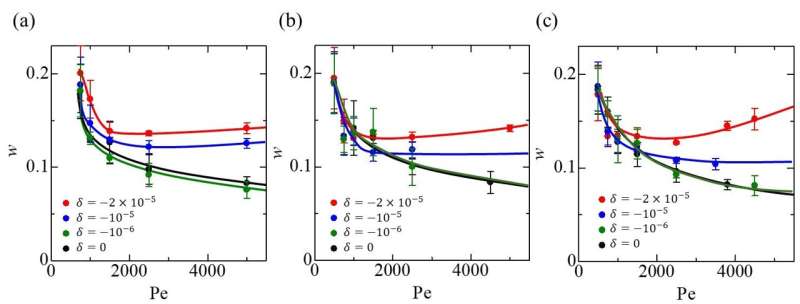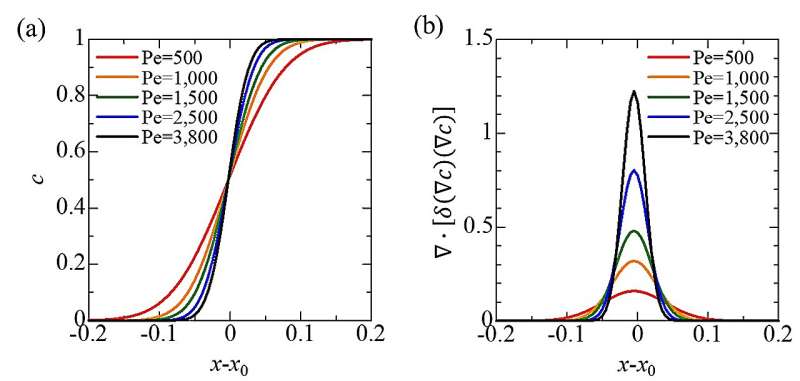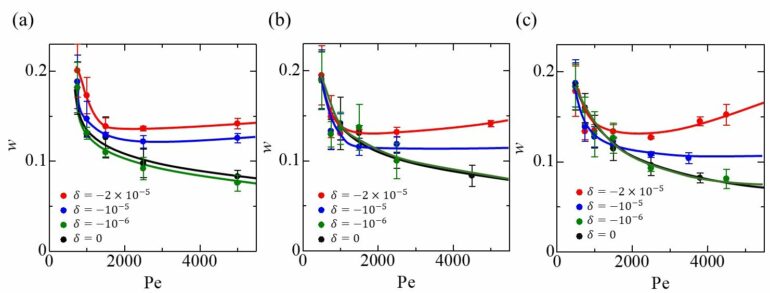Scientists have conducted a study of the interface between two liquids, focusing on a force called interfacial tension. Their numerical simulation helped them better understand the mechanism at work in interfacial tension. This work contributes to the understanding of interfacial fluid dynamics. It offers potential applications in a variety of fields ranging from oil recovery to medical use.
Their work is published in the Journal of Fluid Mechanics.
In the interface between two fluids, scientists consider diffusion to be important in a completely miscible or fully mixed system. By contrast, oil and water are examples of immiscible liquids, that do not mix well together. Scientists have considered interfacial tension to be important in a completely immiscible system. However, even in a completely miscible system, if the mixing process is slow, a force such as interfacial tension is expected to act. This is called effective interfacial tension.
Scientists also know that there is a monotonic relationship—never increasing or decreasing—between the flow strength and the hydrodynamic instability of the interface. The stronger the flow, the greater the hydrodynamic instability. Recent experiments using flow and effective interfacial tension have shown a break in the monotonic relationship. However, the experiments have not clarified the mechanism at work in this process.
“We thought that it would be of academic value in the field of interfacial fluid dynamics to elucidate the mechanism,” said Ryuta X. Suzuki, an assistant professor at the Tokyo University of Agriculture and Technology.

Measured results showing the effect of Pe on finger width for (a) R=0.75, (b) R=1.00 and (c) R=1.25. © Yuka F. Deki, Tokyo University of Agriculture and Technology
The research team used a numerical simulation to clarify the effect of effective interfacial tension on the flow in the mixing process of two solutions. They investigated the effect of the weak interfacial tension, or effective interfacial tension, that occurs between two liquids until they completely mix on the hydrodynamic instability of the interface.
They specifically examined the phenomenon called viscous fingering, in which the interface spreads in a finger-like shape because of the difference in the viscosity of the two fluids. Viscous fingering, also called Saffman-Taylor instability, is a fundamental, yet difficult to control, interfacial instability.
With their numerical simulation, the team obtained results that overturned the conventional wisdom that hydrodynamic instability at the interface increases, that is, the finger width decreases, as the flow velocity increases. Their work clarified the mechanism behind this phenomenon. “In particular, the results of the present study overturned the assumption that the flow strength and instability vary monotonically,” said Manoranjan Mishra, a professor at the Indian Institute of Technology, Ropar.
“This result suggests that the hydrodynamic instability at the interface can be controlled by the effective interfacial tension and the velocity of flow, and is a forerunner to future experimental, numerical, and theoretical studies that will lead to control methods for viscous fingering with effective interfacial tension,” said Suzuki.

(a) Concentration profile for various Pe at t=1 and (b) the value of EIT term with δ=-2×10^(-5) calculated based on (a). © Ryuta X. Suzuki, Tokyo University of Agriculture and Technology
The team views this result as an important discovery that will contribute to the creation of new control methods for enhanced oil recovery processes. They also see their work having important applications in processes where stomach acid does not dissolve the stomach, but only the food. The relationship between gastric acid and gastric mucus is related to this study and may become an important concept in the field of medicine in the future.
“While viscous fingering has been studied since the 1950s, this research is academically valuable because it is a decisive result that overturns the conventional wisdom that there is a monotonous relationship between flow strength and interfacial hydrodynamic instability,” said Suzuki. Looking ahead, the team is hopeful that their work will be a precursor for further experimental, numerical, and theoretical studies on the control method of viscous fingering with effective interfacial tension.
More information:
Yuka F. Deki et al, Numerical study of the effect of Péclet number on miscible viscous fingering with effective interfacial tension, Journal of Fluid Mechanics (2023). DOI: 10.1017/jfm.2023.405
Provided by
Tokyo University of Agriculture and Technology
Citation:
Scientists studying fluid dynamics explore mechanism at work in interfacial tension (2023, August 10)



